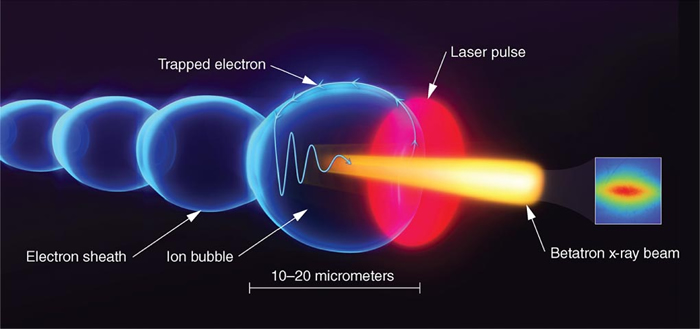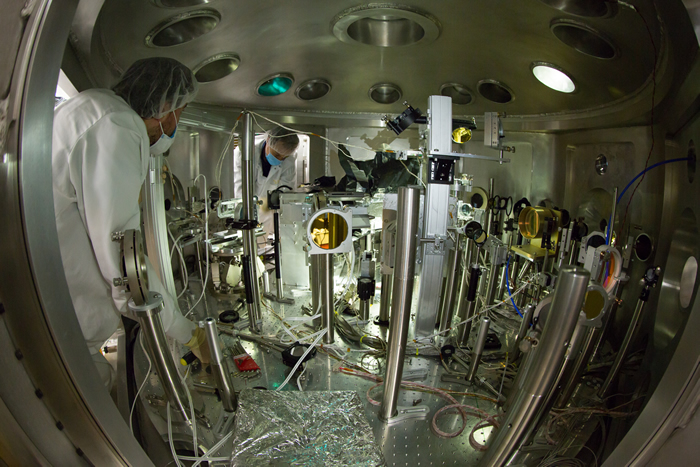Science & Technology - 2015
September
A Pioneering Betatron X-Ray Experiment
Livermore researchers are continually pioneering new experimental methods to investigate changes in materials subjected to extreme conditions of heat and pressure. One example is the use of betatron x-ray radiation for research in the growing field of high energy density (HED) science on extremely short time and length scales (energy density is equivalent to pressure).
 Principle of laser wakefield acceleration, showing the laser pulse, accelerated electron bunch, and longitudinal electrical field. Credit: A.G.R. Thomas, University of Michigan
Principle of laser wakefield acceleration, showing the laser pulse, accelerated electron bunch, and longitudinal electrical field. Credit: A.G.R. Thomas, University of Michigan Betatron radiation is produced when relativistic electrons (traveling at close to the speed of light) are accelerated and oscillate in a laser-driven plasma channel during a process known as laser-wakefield acceleration (LWFA). X-rays produced in this manner are femtoseconds (quadrillionths of a second) in duration, directional, spatially coherent and broadband, making them highly attractive as a probe.
This summer an international team of scientists conducted a unique experiment to explore the advantages of using betatron x-rays to obtain femtosecond-long snapshots of ultrafast electronic and molecular changes in materials.
The research team included NIF physicists Félicie Albert and Brad Pollock and scientists from the SLAC National Accelerator Laboratory, Lawrence Berkeley National Laboratory (LBNL), and the Center for Intense Lasers and Applications (CELIA) and the Laboratory for the Use of Intense Lasers (LULI) in France. It was the first to use this type of radiation in conjunction with SLAC’s Linac Coherent Light Source (LCLS) x-ray and optical laser beams at its Matter under Extreme Conditions experimental end station.
To produce betatron x-rays, a high-powered laser pulse strips electrons from the molecules of a gas, creating a plasma consisting of a cloud of positively charged ions and free electrons. The free electrons are pushed aside by the laser light, and some circle back behind the pulse to be captured in the positively charged ion bubble in the pulse’s wake. These “wakefield” electrons accelerate through the positively charged bubble, oscillating rapidly much like electrons first created in particle accelerators called betatrons in the 1940s. The oscillating wakefield electrons produce high-energy x rays in the femtosecond regime that are synchronous with the initial laser pulse.
 Principle of betatron x-ray emission from a LWFA. Electrons trapped at the back of the wakefield are subject to transverse and longitudinal electrical forces; they are subsequently accelerated and wiggled to produce broadband radiation in the keV energy range.
Principle of betatron x-ray emission from a LWFA. Electrons trapped at the back of the wakefield are subject to transverse and longitudinal electrical forces; they are subsequently accelerated and wiggled to produce broadband radiation in the keV energy range. Albert, an expert in ultrafast x-ray sources and laser-wakefield acceleration, joined LLNL as a postdoctoral researcher in 2008 and became a permanent member of the scientific staff in 2010. She currently works on developing betatron x-ray sources for HED science. She and her colleagues had previously used Livermore’s 200-terawatt Callisto laser and a cell filled with helium gas. The experiments on Callisto produced betatron x rays with up to 80 kiloelectron volts (keV), among the highest ever demonstrated.
The LCLS experiments were funded by LLNL’s Laboratory Directed Research and Development program and DOE’s Office of Fusion Energy Sciences. Albert worked with Pollock on the design, experimental setup, and data analysis and with Rob Costa from LLNL’s Jupiter Laser Facility on the design of the gas cell. Her responsibility was to provide the betatron x-ray source.
The LCLS produces the world’s brightest x-ray pulses, which are used to take snapshots of atoms and molecules subject to extreme conditions, revealing fundamental processes in materials. The facility’s Matter in Extreme Conditions (MEC) instrument combines the unique properties of the LCLS beam with high-power optical laser beams.
Albert said the combination of LCLS’s x-ray and optical laser beams, together with betatron radiation, was unprecedented. LCLS is a world-class x-ray source, but it has a narrow energy band (10-20 eV). On the other hand, the betatron x-ray beam is broadband over several tens of keV, and the absorption of its photons through samples can be observed over hundreds of eV-wide energy ranges. Although Callisto was a 200-terawatt (TW) laser, it could fire only every 30 minutes. At 25 TW, the laser at LCLS has less energy but was sufficient for this experiment. Moreover, the beam was shot every two seconds, ideal for applications where there is a need to accumulate data.
The material under investigation was solid silicon dioxide (SiO2), both in its amorphous and polycrystalline form. SiO2 is used in a number of products including glass and optical fibers. The samples, 400 nanometers (billionths of a meter) thick, were assembled into one-inch-square arrays. The proof-of-principle experiment focused on detecting and characterizing laser-induced non-thermal melting.
Such an event, which takes place in less than one picosecond (trillionth of a second), causes a phase transition in which the structured order of atoms changes so fast that the material “melts” (loses order) without heat. This phase transition had never been diagnosed with both x-ray diffraction and absorption techniques simultaneously. While x-ray diffraction informs about the atomic arrangement of the material under investigation, x-ray absorption spectroscopy is used to diagnose the electronic structure.
 Physicists Eric Galtier of SLAC and Dominik Kraus of LBNL set up an experiment inside the Matter in Extreme Conditions (MEC) hutch of SLAC’s LCLS Far Experiment Hall. Like NIF, the MEC instrument gives scientists the tools to investigate the extremely hot, dense matter at the centers of stars and giant planets. Credit: SLAC National Accelerator Laboratory
Physicists Eric Galtier of SLAC and Dominik Kraus of LBNL set up an experiment inside the Matter in Extreme Conditions (MEC) hutch of SLAC’s LCLS Far Experiment Hall. Like NIF, the MEC instrument gives scientists the tools to investigate the extremely hot, dense matter at the centers of stars and giant planets. Credit: SLAC National Accelerator Laboratory Here, the experiment investigated the absorption of betatron x-rays near the oxygen “K-edge” (around 0.5 keV). When the energy of a betatron photon is slightly below the K-edge energy, the photon has a low probability of being absorbed by the sample. When it is slightly above, the photon has sufficient energy to knock inner shell (or “K-shell”) electrons from the oxygen atoms. This translates into a sharp edge when looking at the absorption vs. photon energy. When the sample is heated this sharp absorption edge changes, a good indicator of electronic structure modifications.
Three different photon beams were directed onto the sample. The first was a laser beam of several millijoules of energy that excited the SiO2 sample. The second was the LCLS beam itself, a 5.5-keV x-ray beam that probed the change in the sample’s atomic structure with x-ray diffraction. Finally, betatron x rays characterized the absorption of x-rays around the oxygen K-edge.
The betatron radiation was generated by a second portion (about one Joule) of the optical laser focused onto a cell containing helium and nitrogen gas. All three beams had to be synchronized within 50 femtoseconds of each other and with micrometer precision. LCLS expertise in using advanced beam synchronization techniques made this possible.
Albert said the experiment was the most complicated she had ever conducted.
Another experimental series is scheduled for March 2016, in which the international team will investigate aluminum’s K-edge. In this case, the sample will be directly heated by the LCLS beam and probed with betatron radiation. Aluminum is important for understanding HED environments and benchmarking codes.
With additional experimental success, betatron x rays could one day be used to take ultrafast snapshots of NIF experiments, for advanced nondestructive imaging, and for a wide range of HED science experiments.
Along with Albert and Pollock, the experimental team was composed of Will Schumaker, Florian Condamine, Jordan Kotick, Siegfried Glenzer, Eric Galtier, Eduardo Granados, Phil Heimann, Hae-Ja Lee, and Alan Fry of SLAC; Dominik Kraus, Alison Saunders, and Roger Falcone of LBNL; Benjamin Barbrel, Fabien Dorchies, Jerome Gaudin, Irene Papagiannouli, and Noemie Jourdain of CELIA; and Alessandra Ravasio of LULI.



